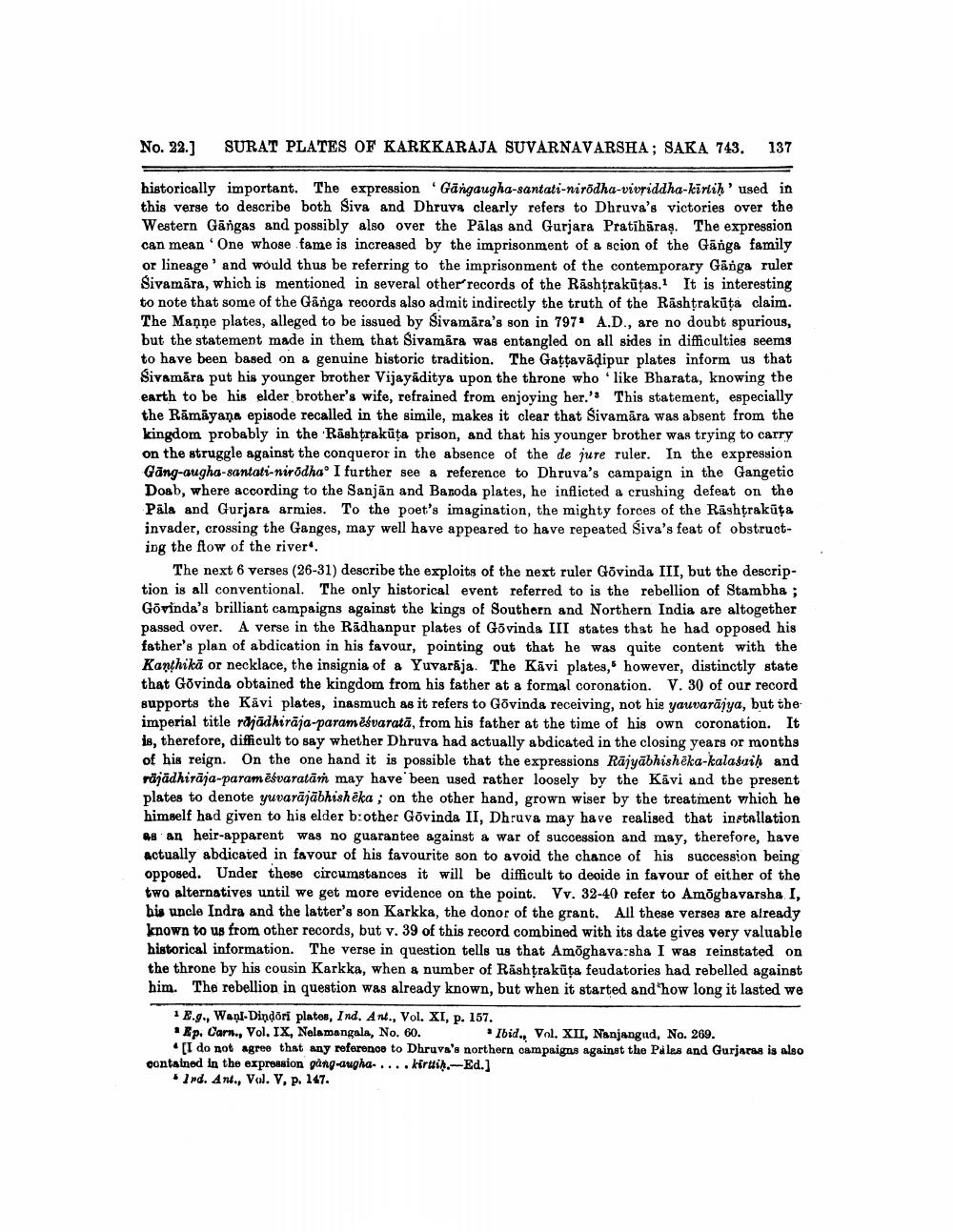________________
No. 22.]
SURAT PLATES OF KARKKARAJA SUVARNAVARSHA; SAKA 743. 137
historically important. The expression 'Gangaugha-santati-nirodha-vivriddha-kirlih' used in this verse to describe both Siva and Dhruvs clearly refers to Dhruva's victories over the Western Gängas and possibly also over the Palas and Gurjara Pratihāras. The expression can mean One whose fame is increased by the imprisonment of a scion of the Gänga family or lineage and would thus be referring to the imprisonment of the contemporary Gänga ruler Sivamāra, which is mentioned in several other records of the Rashtrakūtas. It is interesting to note that some of the Ganga records also admit indirectly the truth of the Rashtrakūta claim. The Manne plates, alleged to be issued by Sivamāra's son in 797 A.D., are no doubt spurious, but the statement made in them that Sivamira was entangled on all sides in difficulties seems to have been based on a genuine historic tradition. The Gattavādipur plates inform us that Sivamāra put his younger brother Vijayāditys upon the throne who like Bharata, knowing the earth to be his elder brother's wife, refrained from enjoying her.' This statement, especially the Rāmāyana episode recalled in the simile, makes it clear that Sivamāra was absent from the kingdom probably in the Rashtrakūta prison, and that his younger brother was trying to carry on the struggle against the conqueror in the absence of the de jure ruler. In the expression Gang-augha-santati-nirodhao I further see a reference to Dhruva's campaign in the Gangetic Doab, where according to the Sanjān and Baroda plates, he inflicted a crushing defeat on the Pāla and Gurjara armies. To the poet's imagination, the mighty forces of the Rashtrakūta invader, crossing the Ganges, may well have appeared to have repeated Siva's feat of obstructing the flow of the river.
The next 6 verses (26-31) describe the exploits of the next ruler Govinda III, but the description is all conventional. The only historical event referred to is the rebellion of Stambha ; Govinda's brilliant campaigns against the kings of Southern and Northern India are altogether passed over. A verse in the Radhanpur plates of Govinda III states that he had opposed his father's plan of abdication in his favour, pointing out that he was quite content with the Kanchikä or necklace, the insignia of a Yuvarāja. The Kävi plates, however, distinctly state that Govinda obtained the kingdom from his father at a formal coronation. V. 30 of our record supports the Kävi plates, inasmuch as it refers to Govinda receiving, not his yauvarājya, but the imperial title rādhiraja-param esvaratā, from his father at the time of his own coronation. It is, therefore, difficult to say whether Dhruva had actually abdicated in the closing years or months of his reign. On the one hand it is possible that the expressions Räjyābhisheka-kalasuih and räjādhiraja-param ēsvaratām may have been used rather loosely by the Kävi and the present plates to denote yuvarājābhisheka, on the other hand, grown wiser by the treatment which he himself had given to his elder b:other Govinda II, Dhruva may have realised that installation as an heir-apparent was no guarantee against a war of succession and may, therefore, have actually abdicated in favour of his favourite son to avoid the chance of his succession being opposed. Under these circumstances it will be difficult to deoide in favour of either of the two alternatives until we get more evidence on the point. Vv. 32-40 refer to Amõgbavarsha I, his uncle Indra and the latter's son Karkka, the donor of the grant. All these verses are already known to us from other records, but v. 39 of this record combined with its date gives very valuable historical information. The verse in question tells us that Amöghava:sha I was reinstated on the throne by his cousin Karkka, when a number of Rashtrakūta feudatories had rebelled against him. The rebellion in question was already known, but when it started and how long it lasted we
12.9., Wal-Dindori plates, Ind. Ant., Vol. XI, p. 157. * Ep. Carn., Vol. IX, Nelamangala, No. 60.
Ibid., Vol. XII, Nanjangud, No. 269. [I do not agree that any referenov to Dhruva's northern campaigns against the Pales and Gurjaras is also contained in the expression gång-augha.....kirti.-Ed.)
. Ind. Ant., Vol. V, p. 147.




